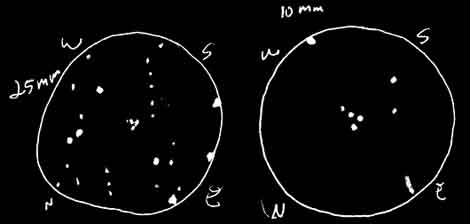
Observation Notes:
This asterism was hard to find. I had to find M72 first, and then move east. It was much smaller and dimmer than I expected–it’s 4 stars after all. The 2 stars on the east end are the brightest. The westernmost star is the dimmest.
Factoids:
This small group of stars was included in Messier’s catalog because he determined its position at the same time he was measuring M72, which is 1.5 degrees to the west. His notes describe it as “Cluster of three or four small stars, which resembles a nebula at first glance, containing very little nebulosity…” As to the nature of this object, there is disagreement over whether the stars are related, or merely a chance alignment of 4 stars at different distances. Additional research needs to be conducted, but if the stars are related, and they are giants, they would be about 2,000 light years distant. If they are actually main sequence stars, they would be somewhat closer.
| Subject | M73/NGC 6994 |
| Classification | Open Cluster/Asterism |
| Position | Aquarius [RA: 20:58.9 / Dec: -12:38]* |
| Size* | 2.8′ |
| Brightness* | 9.0 |
| Date/Time | 10/14/04 – 9:30 PM |
| Observing Loc. | Flagstaff, AZ – Home |
| Instrument | Orion SVP 6LT Reflector (150 mm dia./1200 mm F/L) |
| Eyepieces/Mag. | 25 mm (48X), 10 mm (120X) |
| Seeing | 3/10 |
| Transparency | Mag 5.8 |
* Based on published data.